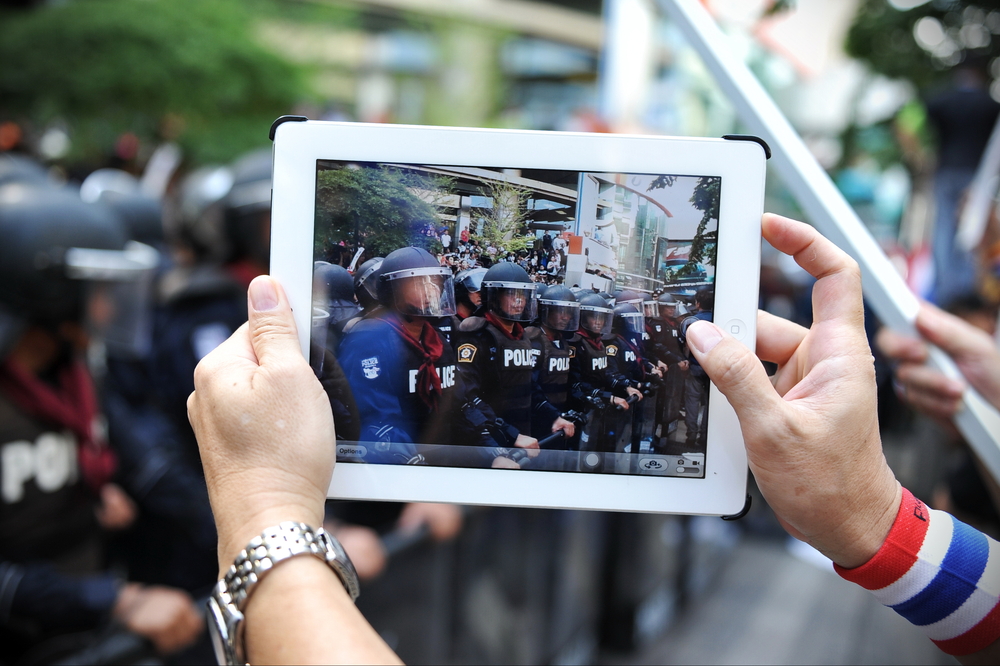
WASHINGTON — While marchers took to the streets to protest the lack of charges against white police officers in the deaths of two unarmed black men, many more turned to social media to voice their objections to the grand jury decisions from their computers and mobile devices.
Two of the most-discussed social media conversations on Thursday questioned the fairness of policing in the United States: (hash)Crimingwhilewhite: self-reported tales of white people committing crimes while police look the other way and (hash)AliveWhileBlack, corresponding stories of harsh treatment of black people by police and authorities. Topsy, a site that offers Twitter analytics, logged more than 300,000 uses of (hash)Crimingwhilewhite in the past day, while (hash)Alivewhileblack had hit almost 65,000.
Other trending terms included (hash)EricGarner and (hash)ICantBreathe, references to victim Eric Garner and the last words he uttered as a New York police wrestled him to the ground. Celebrities, like hip hop mogul Diddy, took to Instagram to express fear and disgust.
“When I see a cop car, I don’t feel safe as a black man. When I see a cop car, I get scared. My kids get scared,” Diddy said in a video posted to his account.
A grand jury’s decision Wednesday not to bring charges against Officer Daniel Pantaleo, who held Garner to the ground, triggered protests around the country that resulted in dozens of arrests. Twitter and other forms of social media quickly became a complement to the protests, particularly among people who shared the protesters’ sentiments but couldn’t join them for various reasons, said Meredith Clark, professor at Frank W. & Sue Mayborn School of Journalism at the University of North Texas in Denton.
“They’re using Twitter as a tool to provide support and to lend their voice to these protests when being there physically is not an option,” Clark said. Social media also provides a forum to express honest thoughts about American life, and “advance conversations in ways we haven’t seen before.”
Garner, 43, died July 17 after scuffling with officers who tried to arrest him for selling untaxed cigarettes. The last moments of his life were caught on video that showed Pantaleo holding the unarmed Garner around the neck as Garner repeatedly gasped, “I can’t breathe.”
On Wednesday, Staten Island District Attorney Daniel Donovan said the grand jury found “no reasonable cause” to charge Pantaleo. That followed an announcement in Missouri last week that a grand jury decided not to indict police officer Darren Wilson for the fatal Aug. 9 shooting of unarmed Michael Brown, 18, in Ferguson. Brown was black; the officer who killed him is white.
Some who engaged in protests over Garner’s and Brown’s deaths worried that venting from the safe confines of the Internet, or what some are calling “armchair activism,” takes away the incentive for direct action. Amanda Seales, 33, a black marcher who took part in protests in New York City on Wednesday night, said more activists needed to get off social media and into the streets. “For black people, this isn’t new,” Seales said.
But Kelly Garrett, professor at the School of Communication at the Ohio State University, said social media actually has the potential to get more people physically involved in movements.
“Yes, there are some people who will stay home because they have said their part,” Garrett said. “But there are also some people who, … having said something and been part of a larger dialogue, they realize, `Hey, you know what, I actually need to do this.'”
Associated Press writer Jacob Pearson contributed to this report.